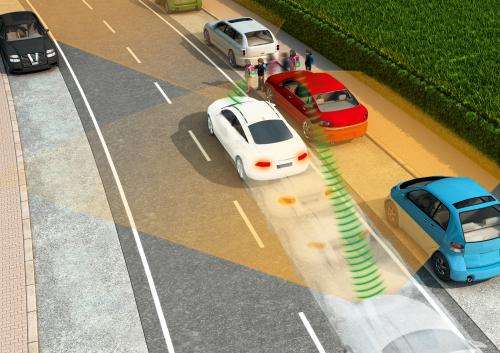Cell phones as life savers: Cars pinpoint pedestrians

Researchers at the Technische Universitaet Muenchen have developed a process that cooperates with driver assistance systems in cars to pinpoint pedestrians and cyclists—even while they are hidden from view. To this end, pedestrian's and cyclist's cell phones could soon serve as transponders. On-board positioning systems would then compute the projected trajectory of the transponders and initiate an emergency braking sequence in case a pedestrian or cyclist moves into the path of a car.
A car drives at 30 km/h through a residential area. Vehicles are parked on the right side of the road. All of a sudden someone appears from behind a large trailer. The car comes to a sudden halt just in front of the pedestrian. Had the vehicle's on-board positioning system not intervened, the car would have hit the pedestrian.
The pedestrian in this test was carrying a so-called transponder. A transponder is a radio transmitter and receiver that responds to specific signals. In this case, the approaching vehicle's positioning system sends the signal. The position of the pedestrian is accurately determined by measuring his or her trajectory and distance from the vehicle.
In the context of the "cooperative transponder" research project, Ko-TAG, Professor Erwin Biebl and his team at the TU Muenchen have developed a completely new approach to distance measurement. The distance to an object can be determined to an accuracy of a few centimeters within just a few microseconds (millionths of a second). The on-board positioning system achieves this by sending a unique series of signals to the transponder. The transponder, in turn, modifies this code sequence and returns it in a very precise temporal pattern.
Safety and acceptance through precise distance measurement
Warning the driver or initiating an emergency braking sequence must generally happen before the pedestrian steps into the street. At the same time, the probability of false alarms must be kept extremely low if drivers are to deem the system effective and use it. An excellent movement prediction is thus indispensible.
In the context of their research, the scientists were able to reduce the measurement errors to a few picoseconds (billionths of a second). "With this, we achieved an accuracy in distance measurement of a few centimeters. Together with the unique code-based process, this is the explanation for the exceptional performance and an important unique selling point of our system," says Professor Biebl.
Locating behind obstacles hitherto impossible
What makes this "cooperative sensor technology," as it is referred to at Ko-TAG, so unique is that it can pinpoint vulnerable road users like pedestrians and cyclists even when they are obstructed from view. Furthermore, they can be uniquely identified as such and their movement patterns can be predicted by the cooperative sensor technology. This is not possible in current driver assistance systems.
The small transmitters can be integrated in clothing or school bags. However, cell phones could also serve as transponders in the future since the majority of people carry a cell phone with them most of the time anyway. Only minor hardware modifications would be required. One major cell phone manufacturer has already expressed interest in the system.
Provided by Technical University Munich




















